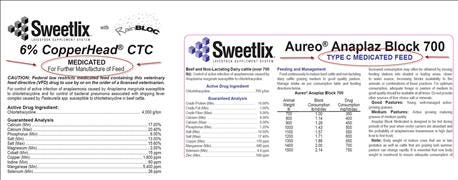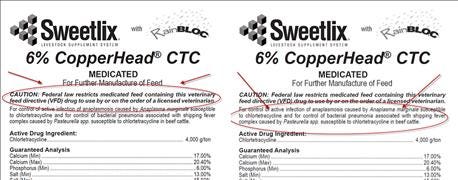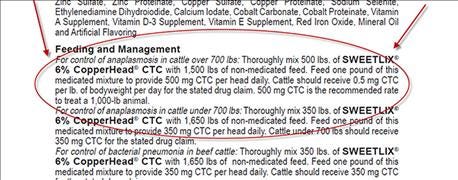September 16, 2016

One of the topics of conversation among feed regulators across the country is the enforcement of VFD rules and on-farm inspection. This shouldn’t concern you as long as you are complying with VFD instructed use and complying with Current Good Manufacturing Practices (CGMP). CGMP may not be a term you are familiar with, but are probably complying with by good old fashioned common sense management.
What are CGMPs?
All manufacturers of medicated feed must follow CGMPs as per the Federal Feed, Drug, and Cosmetic Act Section 501 (a)(2)(B). This applies to anyone making animal feed containing an animal drug, including producers doing on-farm mixing. Following CGMPs helps assure that the feed performs as it should and will not harm the animals or humans consuming products from those animals.

Examples of Type B and Type C Medicated Feed labels. This Type B product is a premix designed to be mixed with other feedstuffs to make a finished feed. This Type C product can be fed directly to target animals without further mixing or processing.
In a nutshell, the CGMPs for on-farm mixing can be distilled down to the following:
Maintain facilities. Buildings and grounds should be suitable for intended use, have adequate space for the job and have suitable housekeeping, including rodent and pest control.
Use the proper equipment. Equipment must be suitable for its intended purpose and be capable of mixing the feed consistently to obtain the correct drug dosage in the final mixed feed.

Example of the required VFD precautionary statement prominently displayed on a VFD product. Requires a veterinary feed directive from a licensed veterinarian prior to use. Also, an example of where to look for the drug claim for a Type B medicated mineral. For example, this item cannot be fed for foot rot control.
Prevent contamination. Potential contaminants such as motor oil, cleaning solvents, fertilizer, herbicides, rodenticides, etc. should be in separate areas than those used to mix feed, store finished feed or store feed ingredient components.

Example of mixing and feeding directions for a Type B medicated mineral. This label should give detailed mixing direction on how much to mix and feed.
Follow label directions. Store medicated items in their original packaging and keep the label so that it can be referenced for product mixing, storage, use, etc. (For bulk deliveries, keep the label in a prominent location where it can be referenced.) A further part of this is to keep records of how much of what you mixed in each feed mixture so that you can trace back if problems occur.
Prevent unsafe drug carryover. Be mindful of drug sequence. Either mix a non-medicated feed for a group of animals that are not sensitive to the previous medication prior to mixing the starter ration, or wash out your mixer to remove any drug residues prior to making a new batch.
Follow the above guidelines, in addition to obtaining VFDs as required, storing paper or electronic copies for 2 years and properly following the use directions on the VFD paperwork as well as on the label of the VFD feed.
Buying a VFD Feed
When your veterinarian gives you a VFD and you purchase the desired drug at your feed store, you will have two options: Type B medicated item (has to be further mixed on-farm prior to use) or a Type C medicated item (can be fed directly as is). The label will identify right away if it is for further manufacture or if it is cleared to be fed directly to the animals.
If a product requires VFD paperwork, the label will prominently display a VFD Caution statement on the label to let you know. This caution also cues your local feed dealer that this product can only be sold upon receipt of a written VFD. The veterinarian, the producer and the feed dealer will all retain copies of this written VFD for a period of 2 years.
The next thing to look for on the label is the drug claim. This states exactly what the active drug in the product will accomplish and in what specie. If there are any weight specifications, it will be noted as well. Feed-through medicated items may only be utilized for the legal drug claim or claims listed on the label. Off-label use is not permitted in drugs administered via feed or water, even with veterinary oversight.
Finally, the next point of interest on the label is the mixing directions (or in the case of a Type C Medicated item, the directions for feeding). The label should include detailed instructions on how to properly mix the Type B medicated premix with non-medicated feed to arrive at a Type C medicated feed. These directions may be in the form of a table set up for multiple feeding rates or it may simply state the amounts needed to mix one ton of feed for one feeding rate. These directions not only cover mixing, but also the feeding of the resulting medicated feed. Be sure to carefully read and follow these directions, especially for a VFD drug.
For more information on SWEETLIX Livestock Supplements or the new VFD rules, visit www.sweetlix.com.
Source: FDA Guidance for Industry 72
About the Author(s)
You May Also Like




